From September 27 to October 8, 1999, I joined "A Tour to Meet the Four Major Chinese Puppet Theaters" whose members were: Mr. TANGE Susumu the leader of the tour, Mr. SONE Kiichi and Ms. TAKEUCHI Toyoko of Puppet Theater PUK, Ms. KAWAJIRI Emiko of Puppet Stage EMI, Mr. FUJIWARA GenYo of the NIHON-UNIMA Secretariat, and myself.
A visiting tour to Chinese puppet theaters had been a long-pending issue of NIHON-UNIMA for years. In 1996, when the Chinese delegation joined the UNIMA Congress in Budapest as observers, we expected their participation in UNIMA soon, although there has been no major change of the situation since then. Discussing the UNIMA activities in Asia, China's absence is one of the major issues we have. The major goal of our tour was to see the present of the Chinese puppetry and to meet the Chinese puppeteers. Mr. TANGE, our leader of the tour, has been active in China, and thanks to his contribution our tour was realized. We visited puppet theaters in Shanghai, Quonzhou, Yangzhou and Beijing.
Shanghai Puppet Theater
Shanghai, the first visiting place in our itinerary, is the largest city in China. A number of enormous buildings, and still more buildings were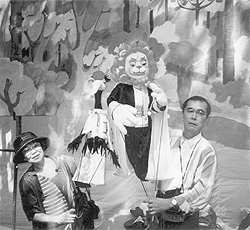 under construction, all of which gave us the strong impression of the economic capital of China. Shanghai Puppet Theater, housed in its own building in the old city, has approximately 100 members. To perform their three productions for the National Day at various sites, most of the members were not there. After meeting with Mr. ZHENG Guo Fang, the director, we were invited to see a performance in the Shanghai zoo. There was a large stage, specially built with the width of almost 12.6 meters, and there were 10 performers accompanied by sound effects and narrations played on a cassette tape deck. There were no lighting equipments, and they had a number of screens and curtains in dark colors that should be carefully chosen for better look in natural light. It seemed the story was about animals trying and seeing who was the cleverest. Manipulation of the puppets were marvelous, quite precise with no hesitation. When we consider it was an outdoor performance, the show seemed rather theatrical. We wanted to see how Chinese children reacted, but we were the only audience because it was on the weekday morning. I did not recognize it until we arrived in China, but the year was the bicentennial of the national foundation, and Shanghai the international city and Beijing was in excitement of a sort, and the puppet theaters were also in this mood. And then we left Shanghai for the next destination. under construction, all of which gave us the strong impression of the economic capital of China. Shanghai Puppet Theater, housed in its own building in the old city, has approximately 100 members. To perform their three productions for the National Day at various sites, most of the members were not there. After meeting with Mr. ZHENG Guo Fang, the director, we were invited to see a performance in the Shanghai zoo. There was a large stage, specially built with the width of almost 12.6 meters, and there were 10 performers accompanied by sound effects and narrations played on a cassette tape deck. There were no lighting equipments, and they had a number of screens and curtains in dark colors that should be carefully chosen for better look in natural light. It seemed the story was about animals trying and seeing who was the cleverest. Manipulation of the puppets were marvelous, quite precise with no hesitation. When we consider it was an outdoor performance, the show seemed rather theatrical. We wanted to see how Chinese children reacted, but we were the only audience because it was on the weekday morning. I did not recognize it until we arrived in China, but the year was the bicentennial of the national foundation, and Shanghai the international city and Beijing was in excitement of a sort, and the puppet theaters were also in this mood. And then we left Shanghai for the next destination.
Quonzhou Municipal Marionette Troupe
It is an hour and a half ride by plane from Shanghai to Xiamen, and an hour and a half drive from Xia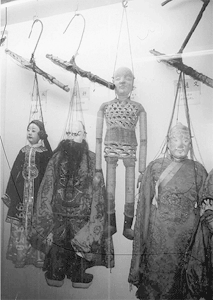 men to Quonzhou. From the coast in Xiamen, we could see the small island of Jinmen Dao, Taiwan, very close. So close that some might try to swim across the sea, we could see a white building of the International Red Cross for rescue. By the road along the coast, there was a sign "Two Regimes, One China", in the size large enough to be read from the Taiwan. We could feel the political tension of the area facing Taiwan. Xiamen is one of the Special Economic Zones of China, and there was also enormous development and construction we could see. After driving fast on the highway, we arrive in the Quenzhou city, a small town with atmosphere of historical background. When we turned a corner from a broad way to a narrow street, there was the theater building. Their show in Taiwan was suddenly postponed due to the major earthquake in Taiwan, and most of the members were having their days off. Mr. WANG Ting Xian the director and several young members were cordially with us for two days. In our conversation, Mr. WANG positively talked that the UNIMA issue was discussed in the China Art Society of Puppets and Shadows, and that he would mention it further on. The theater in Quenzhou often tour to other countries, including Japan, and it seemed that they were eager to display their special puppetry in the international community. The first floor of the building is their exhibition space for historical texts and puppets. Mr. WANG grieved that most of the puppet materials from 500 years ago were fired during the Cultural Revolution. On the National Day, we they brought us to the culture center where they act most of the time. There was the Quenzhou branch of the Fujian Art School also. Their facilities were quite rich, with some classrooms with private rooms and rehearsing stage in the actual size of the real stage. men to Quonzhou. From the coast in Xiamen, we could see the small island of Jinmen Dao, Taiwan, very close. So close that some might try to swim across the sea, we could see a white building of the International Red Cross for rescue. By the road along the coast, there was a sign "Two Regimes, One China", in the size large enough to be read from the Taiwan. We could feel the political tension of the area facing Taiwan. Xiamen is one of the Special Economic Zones of China, and there was also enormous development and construction we could see. After driving fast on the highway, we arrive in the Quenzhou city, a small town with atmosphere of historical background. When we turned a corner from a broad way to a narrow street, there was the theater building. Their show in Taiwan was suddenly postponed due to the major earthquake in Taiwan, and most of the members were having their days off. Mr. WANG Ting Xian the director and several young members were cordially with us for two days. In our conversation, Mr. WANG positively talked that the UNIMA issue was discussed in the China Art Society of Puppets and Shadows, and that he would mention it further on. The theater in Quenzhou often tour to other countries, including Japan, and it seemed that they were eager to display their special puppetry in the international community. The first floor of the building is their exhibition space for historical texts and puppets. Mr. WANG grieved that most of the puppet materials from 500 years ago were fired during the Cultural Revolution. On the National Day, we they brought us to the culture center where they act most of the time. There was the Quenzhou branch of the Fujian Art School also. Their facilities were quite rich, with some classrooms with private rooms and rehearsing stage in the actual size of the real stage.
Yangzhou Puppet Show Troupe
Yangzhou Puppet Show Troupe has their own 5-stories building in the new city. Here also the 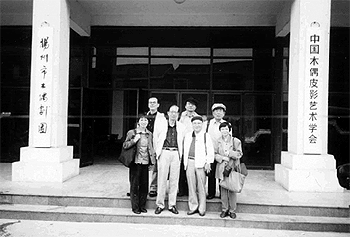 members were out for performances. Mr. JIAO Feng, the chief of the art section, greeted us. He is a director and the chief secretary of the China Art Society of Puppets and Shadows as well. At the entrance of the building, the large sign showed that the China Art Society of Puppets and Shadows was also in this building. They are financially independent, in other words, they have nearly 10 marketing sections including a restaurant, a game arcade, esthetic salon, broadcasting facilities, etc, in addition to the theater group. The fact completely changed our vision to a Chinese puppet theater. The theater facility on the first floor had the auditorium for 800 people, although we couldn't recognized it being used. It seemed that their major activity was touring. We are eager to know how the theater group of such organization develop in future. They said that Mr. Jacques FELIX, the General Secretary of UNIMA, visited China in March. Once referred to the UNIMA issue, Mr. JIAO was careful to say that it was a matter to be decided by the Department of Art and that the Society had no decision. The theater in Yangzhou has a close relation with Japan, and Mr. JIAO cordially extended his hospitality. I assume that his unique business management might be somewhat influenced by his members were out for performances. Mr. JIAO Feng, the chief of the art section, greeted us. He is a director and the chief secretary of the China Art Society of Puppets and Shadows as well. At the entrance of the building, the large sign showed that the China Art Society of Puppets and Shadows was also in this building. They are financially independent, in other words, they have nearly 10 marketing sections including a restaurant, a game arcade, esthetic salon, broadcasting facilities, etc, in addition to the theater group. The fact completely changed our vision to a Chinese puppet theater. The theater facility on the first floor had the auditorium for 800 people, although we couldn't recognized it being used. It seemed that their major activity was touring. We are eager to know how the theater group of such organization develop in future. They said that Mr. Jacques FELIX, the General Secretary of UNIMA, visited China in March. Once referred to the UNIMA issue, Mr. JIAO was careful to say that it was a matter to be decided by the Department of Art and that the Society had no decision. The theater in Yangzhou has a close relation with Japan, and Mr. JIAO cordially extended his hospitality. I assume that his unique business management might be somewhat influenced by his
The Puppet Art Troupe of China
At the end of the tour, we visited the theater in Beijing, that has the name representing their country as a whole. Within the new city of Beijing, the suburb where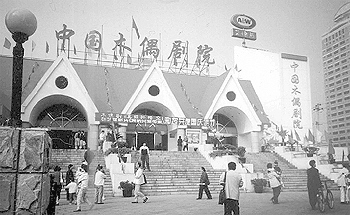 housing development is, they have their Puppet Theater of China that has three stages: large, medium and small. They were performing in the theater during the National Day holidays, and the fact depicted their status of being the major puppet theater of China. The show in the large theater was "Real Monkey King"; the battle between the real Monkey King and a bogus Monkey King was harmful to people so Buddha intervenes to settle the situation. The roles of the two Monkey Kings were played by the two young disciples of Mr. TAN Zhi Yuan the puppet master who had been working in Japan for years. Their fighting scenes were sharp and speedy. The style of the masked man who talked to the audience several times during the show was an influence from a Japanese group, they said. With more theatrically new styles, such as manipulators being visible, the show was carefully planned to attract children. housing development is, they have their Puppet Theater of China that has three stages: large, medium and small. They were performing in the theater during the National Day holidays, and the fact depicted their status of being the major puppet theater of China. The show in the large theater was "Real Monkey King"; the battle between the real Monkey King and a bogus Monkey King was harmful to people so Buddha intervenes to settle the situation. The roles of the two Monkey Kings were played by the two young disciples of Mr. TAN Zhi Yuan the puppet master who had been working in Japan for years. Their fighting scenes were sharp and speedy. The style of the masked man who talked to the audience several times during the show was an influence from a Japanese group, they said. With more theatrically new styles, such as manipulators being visible, the show was carefully planned to attract children.
I saw their motivation to create new styles. On the other hand, I felt more improvements could be made with their text and direction. On the last day of our stay in China, we visited the theater office in downtown. Mr. CHU Yung Chun the director and his members greeted us. A world atlas was hanged on the wall in their meeting room. When we talked about the present of UNIMA and our intention to promote puppetry exchange in Asia, Mr. CHU quietly answered to us; although there are several obstacles, someday Chinese puppet theaters would join UNIMA. Learning from other Asian regions, especially from Japan where puppetry is flourishing, will promote the further progress of Chinese puppetry. My dream after my retirement is to establish an theatrical university including course on puppetry, he said. The party at that night was full of excitements and joy. And then, we departed after enthusiastic greetings.
I saw that the Chinese puppetry scene is in the period of major changes. Although they have governmental support, most of their ticket income goes to the theater. Their management efforts would establish their financial independence. That means their creative independence is being sought. Most of the leaders in each theater has changed to younger generation. Directors and Assistant Directors are in their thirties or forties. They are the ones who entered the puppet school of the theater after the entrance examination that only one out of one hundred would have passed, followed by 5 years of training, 10 hours a day, before becoming a member of the theater. They have ultimate confidence in their traditional expression and puppet manipulation. International exchange would make their technique meet a new horizon of creation, and I imagine how that would be. We talked to them that we would like to have an Asian puppetry festival within few years, and all of them appreciated our idea. Our present task is communication with a concrete goal. Therefore, I felt we need to have a way to exchange our information and more meetings that are not very official.
[ Translated by TAMAKI Nobuko ]
|
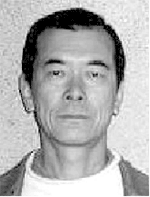
 under construction, all of which gave us the strong impression of the economic capital of China. Shanghai Puppet Theater, housed in its own building in the old city, has approximately 100 members. To perform their three productions for the National Day at various sites, most of the members were not there. After meeting with Mr. ZHENG Guo Fang, the director, we were invited to see a performance in the Shanghai zoo. There was a large stage, specially built with the width of almost 12.6 meters, and there were 10 performers accompanied by sound effects and narrations played on a cassette tape deck. There were no lighting equipments, and they had a number of screens and curtains in dark colors that should be carefully chosen for better look in natural light. It seemed the story was about animals trying and seeing who was the cleverest. Manipulation of the puppets were marvelous, quite precise with no hesitation. When we consider it was an outdoor performance, the show seemed rather theatrical. We wanted to see how Chinese children reacted, but we were the only audience because it was on the weekday morning. I did not recognize it until we arrived in China, but the year was the bicentennial of the national foundation, and Shanghai the international city and Beijing was in excitement of a sort, and the puppet theaters were also in this mood. And then we left Shanghai for the next destination.
under construction, all of which gave us the strong impression of the economic capital of China. Shanghai Puppet Theater, housed in its own building in the old city, has approximately 100 members. To perform their three productions for the National Day at various sites, most of the members were not there. After meeting with Mr. ZHENG Guo Fang, the director, we were invited to see a performance in the Shanghai zoo. There was a large stage, specially built with the width of almost 12.6 meters, and there were 10 performers accompanied by sound effects and narrations played on a cassette tape deck. There were no lighting equipments, and they had a number of screens and curtains in dark colors that should be carefully chosen for better look in natural light. It seemed the story was about animals trying and seeing who was the cleverest. Manipulation of the puppets were marvelous, quite precise with no hesitation. When we consider it was an outdoor performance, the show seemed rather theatrical. We wanted to see how Chinese children reacted, but we were the only audience because it was on the weekday morning. I did not recognize it until we arrived in China, but the year was the bicentennial of the national foundation, and Shanghai the international city and Beijing was in excitement of a sort, and the puppet theaters were also in this mood. And then we left Shanghai for the next destination. men to Quonzhou. From the coast in Xiamen, we could see the small island of Jinmen Dao, Taiwan, very close. So close that some might try to swim across the sea, we could see a white building of the International Red Cross for rescue. By the road along the coast, there was a sign "Two Regimes, One China", in the size large enough to be read from the Taiwan. We could feel the political tension of the area facing Taiwan. Xiamen is one of the Special Economic Zones of China, and there was also enormous development and construction we could see. After driving fast on the highway, we arrive in the Quenzhou city, a small town with atmosphere of historical background. When we turned a corner from a broad way to a narrow street, there was the theater building. Their show in Taiwan was suddenly postponed due to the major earthquake in Taiwan, and most of the members were having their days off. Mr. WANG Ting Xian the director and several young members were cordially with us for two days. In our conversation, Mr. WANG positively talked that the UNIMA issue was discussed in the China Art Society of Puppets and Shadows, and that he would mention it further on. The theater in Quenzhou often tour to other countries, including Japan, and it seemed that they were eager to display their special puppetry in the international community. The first floor of the building is their exhibition space for historical texts and puppets. Mr. WANG grieved that most of the puppet materials from 500 years ago were fired during the Cultural Revolution. On the National Day, we they brought us to the culture center where they act most of the time. There was the Quenzhou branch of the Fujian Art School also. Their facilities were quite rich, with some classrooms with private rooms and rehearsing stage in the actual size of the real stage.
men to Quonzhou. From the coast in Xiamen, we could see the small island of Jinmen Dao, Taiwan, very close. So close that some might try to swim across the sea, we could see a white building of the International Red Cross for rescue. By the road along the coast, there was a sign "Two Regimes, One China", in the size large enough to be read from the Taiwan. We could feel the political tension of the area facing Taiwan. Xiamen is one of the Special Economic Zones of China, and there was also enormous development and construction we could see. After driving fast on the highway, we arrive in the Quenzhou city, a small town with atmosphere of historical background. When we turned a corner from a broad way to a narrow street, there was the theater building. Their show in Taiwan was suddenly postponed due to the major earthquake in Taiwan, and most of the members were having their days off. Mr. WANG Ting Xian the director and several young members were cordially with us for two days. In our conversation, Mr. WANG positively talked that the UNIMA issue was discussed in the China Art Society of Puppets and Shadows, and that he would mention it further on. The theater in Quenzhou often tour to other countries, including Japan, and it seemed that they were eager to display their special puppetry in the international community. The first floor of the building is their exhibition space for historical texts and puppets. Mr. WANG grieved that most of the puppet materials from 500 years ago were fired during the Cultural Revolution. On the National Day, we they brought us to the culture center where they act most of the time. There was the Quenzhou branch of the Fujian Art School also. Their facilities were quite rich, with some classrooms with private rooms and rehearsing stage in the actual size of the real stage. members were out for performances. Mr. JIAO Feng, the chief of the art section, greeted us. He is a director and the chief secretary of the China Art Society of Puppets and Shadows as well. At the entrance of the building, the large sign showed that the China Art Society of Puppets and Shadows was also in this building. They are financially independent, in other words, they have nearly 10 marketing sections including a restaurant, a game arcade, esthetic salon, broadcasting facilities, etc, in addition to the theater group. The fact completely changed our vision to a Chinese puppet theater. The theater facility on the first floor had the auditorium for 800 people, although we couldn't recognized it being used. It seemed that their major activity was touring. We are eager to know how the theater group of such organization develop in future. They said that Mr. Jacques FELIX, the General Secretary of UNIMA, visited China in March. Once referred to the UNIMA issue, Mr. JIAO was careful to say that it was a matter to be decided by the Department of Art and that the Society had no decision. The theater in Yangzhou has a close relation with Japan, and Mr. JIAO cordially extended his hospitality. I assume that his unique business management might be somewhat influenced by his
members were out for performances. Mr. JIAO Feng, the chief of the art section, greeted us. He is a director and the chief secretary of the China Art Society of Puppets and Shadows as well. At the entrance of the building, the large sign showed that the China Art Society of Puppets and Shadows was also in this building. They are financially independent, in other words, they have nearly 10 marketing sections including a restaurant, a game arcade, esthetic salon, broadcasting facilities, etc, in addition to the theater group. The fact completely changed our vision to a Chinese puppet theater. The theater facility on the first floor had the auditorium for 800 people, although we couldn't recognized it being used. It seemed that their major activity was touring. We are eager to know how the theater group of such organization develop in future. They said that Mr. Jacques FELIX, the General Secretary of UNIMA, visited China in March. Once referred to the UNIMA issue, Mr. JIAO was careful to say that it was a matter to be decided by the Department of Art and that the Society had no decision. The theater in Yangzhou has a close relation with Japan, and Mr. JIAO cordially extended his hospitality. I assume that his unique business management might be somewhat influenced by his housing development is, they have their Puppet Theater of China that has three stages: large, medium and small. They were performing in the theater during the National Day holidays, and the fact depicted their status of being the major puppet theater of China. The show in the large theater was "Real Monkey King"; the battle between the real Monkey King and a bogus Monkey King was harmful to people so Buddha intervenes to settle the situation. The roles of the two Monkey Kings were played by the two young disciples of Mr. TAN Zhi Yuan the puppet master who had been working in Japan for years. Their fighting scenes were sharp and speedy. The style of the masked man who talked to the audience several times during the show was an influence from a Japanese group, they said. With more theatrically new styles, such as manipulators being visible, the show was carefully planned to attract children.
housing development is, they have their Puppet Theater of China that has three stages: large, medium and small. They were performing in the theater during the National Day holidays, and the fact depicted their status of being the major puppet theater of China. The show in the large theater was "Real Monkey King"; the battle between the real Monkey King and a bogus Monkey King was harmful to people so Buddha intervenes to settle the situation. The roles of the two Monkey Kings were played by the two young disciples of Mr. TAN Zhi Yuan the puppet master who had been working in Japan for years. Their fighting scenes were sharp and speedy. The style of the masked man who talked to the audience several times during the show was an influence from a Japanese group, they said. With more theatrically new styles, such as manipulators being visible, the show was carefully planned to attract children.